100 Carbs Per Day Diet
 Did you know that one of the most commonly asked questions we get is: how many carbs per day is best for a diabetic to eat?
Did you know that one of the most commonly asked questions we get is: how many carbs per day is best for a diabetic to eat?
No doubt that's why you're here reading this as well, right?
And like many other people you may be totally confused by that question.
That's not surprising because the amount of carbs recommended does vary depending on where you read it.
Why is this?
Well, there is no specific recommendation for the amount of carbohydrate, that's why there are so many different numbers.
However, there is good scientific evidence to suggest what's best. But unfortunately, that information is not getting out to the public (to YOU) as fast as it should.
Luckily though, here at Diabetes Meal Plans, we pride ourselves on sharing up-to-date evidence-based info because we want you to get the best results. And we're proud to say what we share works:
 Sheryl says: "My doctor's report was best ever: A1c was normal for the first time since I was diagnosed diabetic in 2007; My LDL was 60; my total cholesterol was 130. My lab results were improved across the board. Best news: I am taking less diabetic meds, and my weight is within 5 lbs of normal BMI. I am a believer in what you have written, and I'm grateful to have a site I can trust."
Sheryl says: "My doctor's report was best ever: A1c was normal for the first time since I was diagnosed diabetic in 2007; My LDL was 60; my total cholesterol was 130. My lab results were improved across the board. Best news: I am taking less diabetic meds, and my weight is within 5 lbs of normal BMI. I am a believer in what you have written, and I'm grateful to have a site I can trust."
Here at Diabetes Meal Plans we encourage a low carb diet because research shows that lower carb diets produce far more effective results than traditional low fat diets.
As you read on, be prepared to have some of your longheld diet beliefs shattered. But also be prepared to be amazed by the possibilities. Because with a few dietary changes, you can reverse* your diabetes and live your life anew!
Rethinking 'Mainstream' Carb Recommendations
Over the years it's been pretty common practice to recommend a low fat, high carbohydrate diet to people with type 2 diabetes or prediabetes.
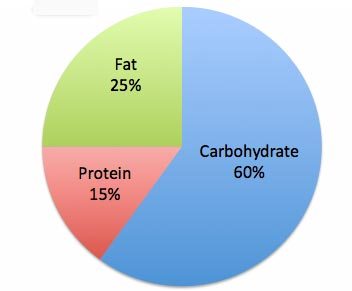
Even as little as a few months ago, the American Diabetes Association were still stating that: "A place to start is at about 45-75 grams of carbohydrate at a meal."
That would equate to around 135-225 g carbohydrates per day, excluding snacks.
And globally, diabetes associations have kept emphasizing that people with type 2 diabetes should eat the same as the general population (a high carb, low fat diet), that everything in moderation is fine (sorry but even a small piece of cake or an every night 'moderate' intake of ice cream, or that morning fresh fruit juice can be harmful).
So quite frankly, these large organizations have had you fooled – none of their dietary information has been based on real science!
And the fact is, 45-75 g per meal of carbohydrates per meal is way too high!
If you've been eating 225+ grams of carbs per day and wondering why you can't get your blood glucose levels or A1c under control, there's a simple answer — you're eating too many carbs!
What the science shows is you must forget the 'mainstream' carb recommendations and flip the nutrition circle on it's head. Because the goal is to keep your carb intake to less than 25%, not 60% as these large health organizations have been pushing for years.
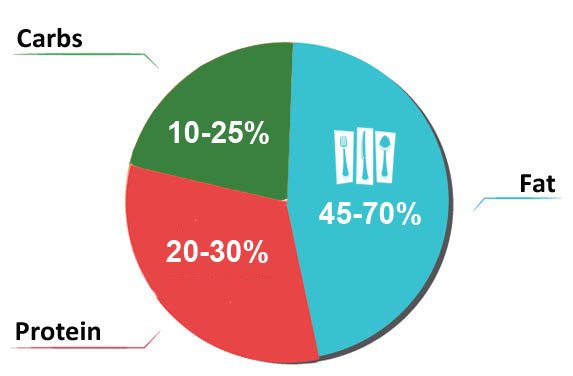
As you can see, these recommendations suited for the 'general' public are highly flawed recommendations for people with type 2 diabetes, and are in fact, keeping you sick!
Like we always say: Diabetes prevention and diabetes treatment are two completely different things.
So be careful because many things you read online lump both prevention and treatment into the same boat – but they are completely different. Here at DMP, we focus on TREATMENT.
The good news is that since we started sharing research here way back in 2015, diabetes organizations have slowly shifted their views and now recognize that a low carb diet is an effective option for diabetes management – thank goodness!!
So, How Many Carbs Should You Eat?
It does vary some from person to person. But overall your goal is to keep your carbohydrate intake to less than 130 grams per day, which is considered the top threshold for a low carb diet.
Still, although anything below 130 grams is considered low carb, and it's a good place to start, 130 grams is not that low.
Research shows that if you can eat even fewer carbs, you'll get even better results:
- Great blood sugar control
- Lower A1c
- Increased weight loss
- Improved cholesterol
- Lower inflammation
- Reduction in medication
What we've found works well for our members is to consume around 50 to 80 grams of total carbs per day. Yes, that's 50-80 g maximum carbs per day!
So, when you start carb counting, if you were calculating 'net carbs' (total carbs minus fiber = net carbs), you'd be consuming around 30 to 50 net carbs per day.
And if you do this, you'll be seeing great improvements!
Leisa M says: "I started the 30 Day Turnaround Program to help me figure out how to eat low carb since that is what my nutritionist recommended. My blood glucose was reading 250 to 300. My readings are now within normal range…just checked. And I'm sitting at 97 before lunch. I'm down over 20 pounds and feeling so much better. Thank you."
Here's the thing, you can choose to eat a higher carb diet but over time you will likely find it difficult to control your blood sugar levels and many find you need to continually increase your medication. And the reality is, if you struggle to maintain your blood sugar within a healthy range, you put yourself at higher risk for nasty diabetic complications.
Whereas, if you adopt new ways of eating, switching to a lower carb diet, you can reverse* your diabetes. Yes, that's right!
While diabetes is not reversible from a diagnostic standpoint — once you have it, you have it — it can be reversible from a physiological standpoint, which means you can keep your blood sugar within a normal healthy range, stay off or minimize meds, and live a healthy life — a lower carb diet can help you do that – it's happening with our members all the time!
A Word Of Caution!
If you are on insulin therapy, it is important to lower your carb intake under close supervision of your health practitioner because you will have to make adjustments to your dosage and a fast rapid change can result in hypoglycemia. Monitor your blood sugar levels closely when making dietary transitions and be aware of symptoms.
Please pin, tweet or share; then continue reading 🙂
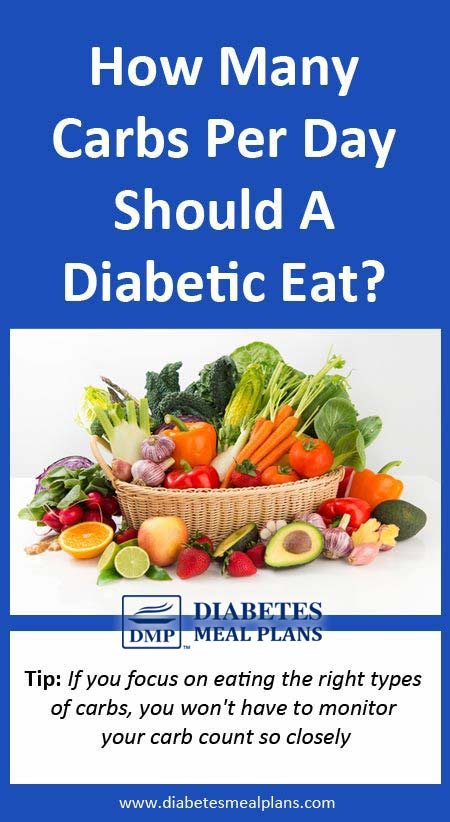
Where To Get Started With Carbs
Since most people usually have to lower carb intake quite a bit, 120 grams is often a comfortable place to start and then you can tweak and reduce your own individual intake from there.
In the 30 Day Turnaround Program, we show you how to reduce your carbs to lower blood sugar and A1c, giving you delicious healthy food options, ideas, and alternatives for all the 'normal' high carb foods you might be used to eating.
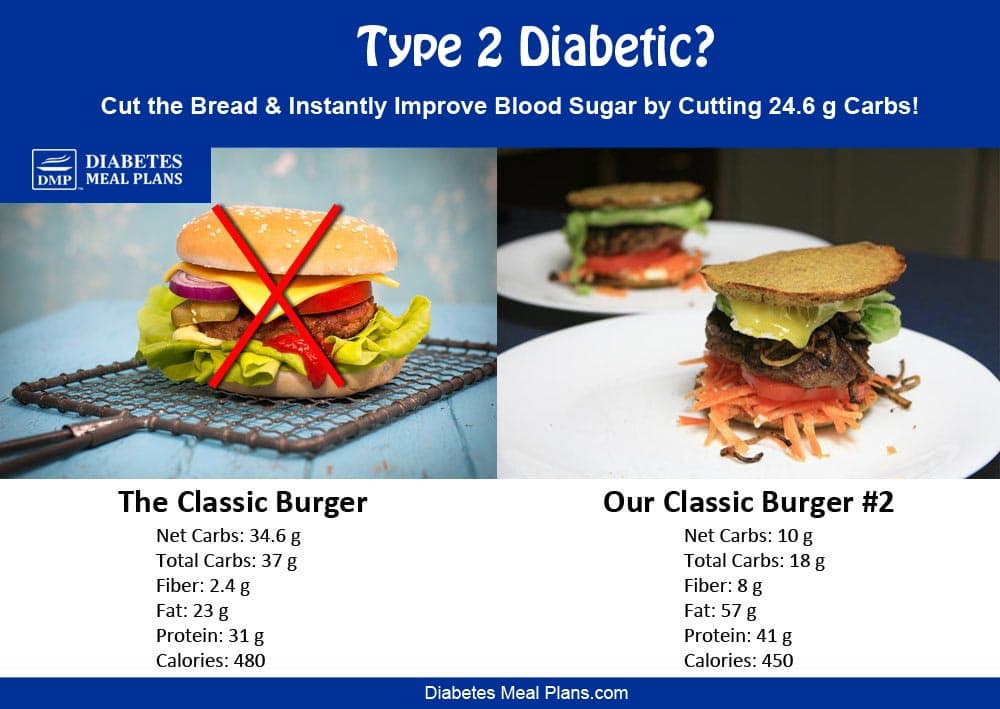
But, let's break 120 grams down per meal right now.
Carbs per meal
- Breakfast: 30 g carbs
- Lunch: 30 g carbs
- Dinner: 30 g crabs
- 2 x snacks: 15 g carbs each or 3 x snacks 10 g carbs each
This tends to work fairly well for the majority of people when getting started.
For Optimal Long-Term Results: Aim For 50-80 g Day
If you focus on eating the right types of carbohydrates, then you won't really have to focus on carbohydrate counting so closely (what a relief!).
Essentially the right type of diet for lowering blood sugar and A1c is a high plant-based, anti-inflammatory diet, whole foods, low carb diet.
This sounds complicated but it's not. Just stick to eating real food and choose non-starchy vegetables as your predominant source of carbohydrates.
Then, over a days worth of eating, your veggie intake, and the addition of some low carb fruits, will add up to around 50-80 grams per day.
This seems to be the sweet spot for managing blood sugar and A1C, and is sustainable for many.
You may also hear about a 'very low carb diet ketogenic diet,' such as an Atkin's diet, which limits carbs to 20 g per day. But health experts such as Mark Sisson and Dr Mark Hyman, suggest that it's not necessary to limit carbs this low because it cuts out many of the essential plant ingredients that we need — and we tend to agree with this point of view.
For instance, a ketogenic diet limits carrots, but carrots provide valuable nutrients and loads of dietary fiber. And while carrots are a little higher in carbs than spinach, they still aren't really a high carb food, like potatoes, rice, bread, pasta and cereals.
You've probably also heard of things such as the glycemic index, and it's true, numerous research studies suggest that a low glycemic index diet plan can be effective for weight loss and blood sugar management.
What makes something a low glycemic index food?
Fiber.
It's as simple as that, you need LOTS of fiber (from consuming lots of vegetables) – and the type of low carb diet we encourage includes ample amounts of fiber each day!
50-80 g Per Day Sample Meal Plan
Breakfast: Veggie scramble – 15 g (aim for between 10-20g)
Lunch: Chicken & veggie salad – 15 g (aim for between 10-20g)
Dinner: Beef coconut curry – 12-15 g (aim for between 10-20g)
Snacks: Berry Bomb 5 g, peanut butter with carrot sticks 5 g, or cottage cheese and berries 10 g. Aim for 5-15 g per snack.
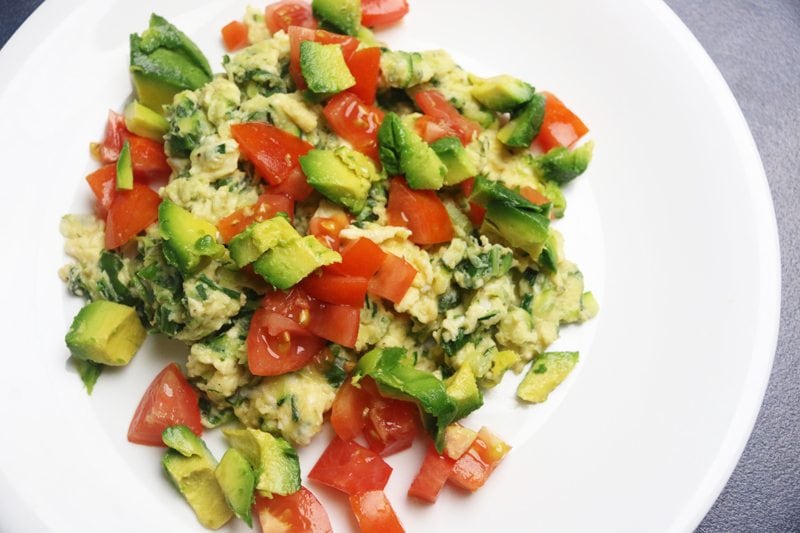
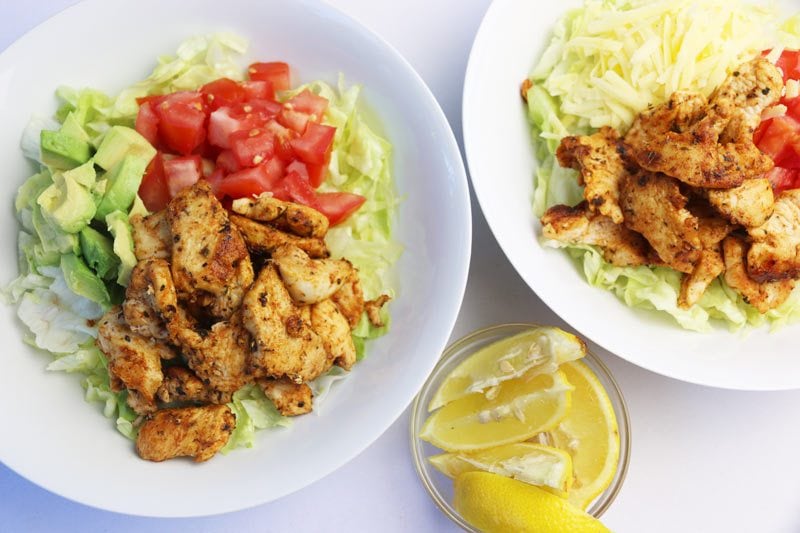
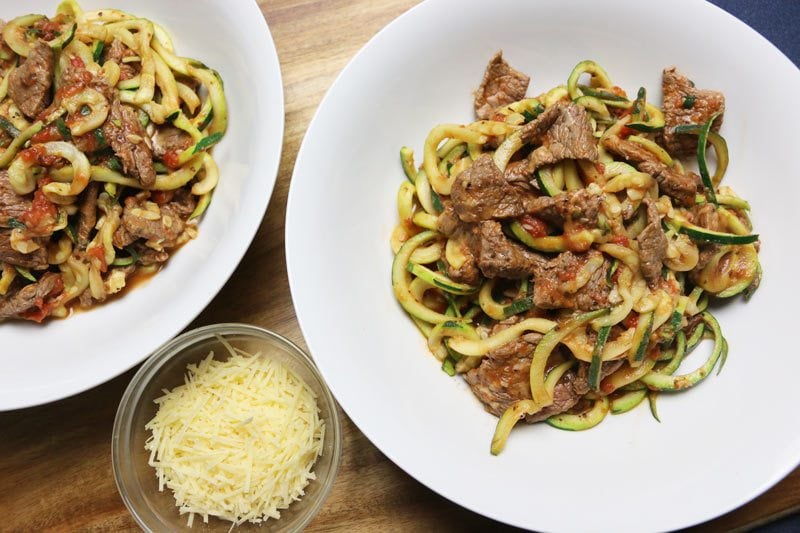
Based off the meals and snacks above the total daily carbs is: 62 grams.
Factoring in around 25-30 g fiber, your net carbs would be around 37-32 grams.
As you can see from this meal plan, you will not be starving!
But it is a different way to eat than you're probably used to. That's why we're here to help you.
The 30 Day Turnaround Program walks you step-by-step to putting a low carb healthy eating plan into practice.
We show you exactly HOW to eat to get results, revealing the carb content of problem foods and giving you ample low carb options and alternatives for regular high carb foods – and we make it easy to manage your meal planning over the long term!
Busting a Few Nutrition Myths
Avoid grain-based foods: You do not need to eat whole grain foods to get fiber and 'good' carbs. You can obtain plenty of fiber from vegetables, nuts and seeds. And grain-based foods, even whole grains are high in carbs and will raise blood sugar.
Enjoy dairy: Dairy products are fine to eat, even full fat varieties. There is no evidence to show these are bad for our health. And in fact, new evidence suggests they are very beneficial. In terms of carbs, cheese and cottage cheese are lower in carbs than milk and yogurt.
Become a detective: When you go shopping, don't rely on front-of-pack labelling. Food companies are great at enticing you to purchase foods, or telling you that a food is healthy, but it may not be true. The only way you'll know is to read food labels and learn to understand the nutrition facts panel. When looking at nutrition labels, don't just look at the total calories, observe the amount of carbs, fiber and how much sugar an item contains.
Carbs are more important than calories: But overall, the best bet for your diabetes diet is to focus on carb control. When you can observe your daily intake of carbs and lower them, you will see results pretty quickly. And just to be clear, we are talking about a low carb diet here, not a no carb diet! Sure, in the long term, calorie intake is important to achieve and maintain a healthy weight. If you need to, on a lower carb diet, you can control calorie intake by focusing on the amount of food you eat.
Your Practical Action Steps Right Now
If your diet is currently pretty poor or you're just getting started, begin with around 120 g per day of carbs.
- Breakfast: 30 g carbs
- Lunch: 30 g carbs
- Dinner: 30 g crabs
- 2 x snacks: 15 g carbs each or 3 x snacks 10 g carbs each
If you want to work on losing weight and getting optimal results for blood sugar and a1c aim for 50-80 g carbs per day.
- Breakfast: 15-20 g carbs
- Lunch: 15-20 g carbs
- Dinner: 15-20 g crabs
- 2 x snacks: 5-10 g carbs each
- Before bed: 10 g carbs
If you don't know what carbohydrate foods are, or which ones are best to eat – take the 30 Day Turnaround Program – our members discover that after years of trying diet after diet without success, our process truly turns their lives around!
"My a1c started out around 9.5. It has been at 5.4 for the past six months. I have lost close to 50 pounds. Thanks again for all the great recipes and help." ~JoAnn B.
"I'm making healthier food choices. Cooking again (huge step) because you've shown me quick plans. And prepping and packing lunches! Wish the doctor's office would have shown YOUR way of doing it when I was first diagnosed. I probably would not have stuck my head in the sand so long! Glad I found you!" ~ Michelle G.
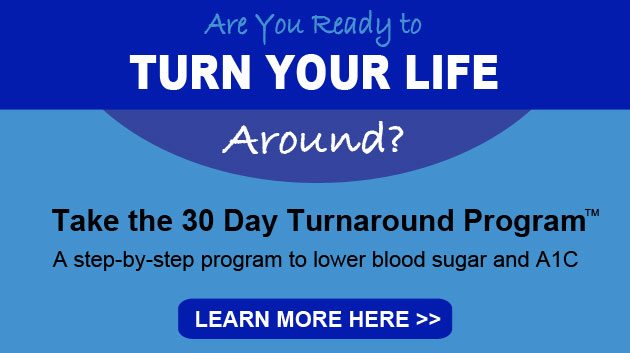
P.S. Please share this info with friends, family or colleagues – it could be life changing. 🙂
*Reverse diabetes: while diabetes is not reversible from a diagnostic standpoint — once you have it, you have it — diabetes can be reversible from a physiological standpoint, in many. That is, you can endeavor to bring your blood sugar and A1c levels within a normal healthy range, improve your metabolism, reduce the need for meds and live a healthy, happy, 'normal' life.
With a few simple changes to your diet — lowering carb intake and eating whole foods — you can start seeing your numbers move in a downward direction, fast!
Take the 30 Day Turnaround Program – we'll show you how easy it is to do.
Save
Source: https://diabetesmealplans.com/47/how-many-carbs-per-day-for-a-diabetic/